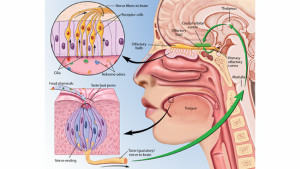Taste is an important part of our daily lives, at least for me it is! The importance of taste roots back to our ancestors; Sweetness identified energy-rich nutrients, while bitter warned for potential poisons and chemicals. Although the taste receptors on our tongue play a role is taste recognition, our brain is what truly recognizes flavors. Most people assume that it is the tongue telling the brain what we’ve tasted, but it’s actually the opposite. Dr. Charles S. Zuker, professor at Columbia University Medical Center, summarizes it as, “Taste, the way you and I think of it, is ultimately in the brain. Dedicated taste receptors in the tongue detect sweet or bitter and so on, but it’s the brain that affords meaning to these chemicals.”
(Diagram of how taste works, http://www.brainfacts.org/sensing-thinking-behaving/senses-and-perception/articles/2012/taste-and-smell/)
Zuker and his colleagues have already proved the existence of dedicated receptors for each taste on the tongue. They did this by feeding mice certain tastes and using an infrared light to gain information about which cells were activated. Zuker and his team now created an experiment to reveal how the brain transforms detection of chemical stimuli into perception. The researches did this by manipulating cell in the brain of mice in order to change the way something tasted. They focused their attention on a certain part of the mice’s brain called the gustatory cortex. The gustatory cortex is responsible for the perception of taste; It is made up of nerve cells responsible for sensing bitter and sweet.
The Experiment:
The scientists in this study used optogenetics, which is a biological technique that involves the use of light to control cells. This allowed them to directly activate specific neurons with a laser. The researched wanted to know if manipulated these neurons could evoke the perception of tastes that aren’t actually there. They hypothesized that if they were able to silence these regions, it would prevent the animal from tasting sweet or bitter, and if they activated these regions, they would taste sweet or bitter even if they were only receiving plain water.
The researchers were correct. When they injected the mice with a substance that silenced the sweet neuron, the mice could only taste bitter. The same thing happened when the silenced bitter, the mice could only taste sweet. The researches could also trick the mice into thinking they were tasting bitter or sweet while they were drinking plain water. They did this by activating the sweet neurons while the mouse was drinking; they observed behaviors associated with sweet, like increased licking. The same results happening with bitter neurons; when they were activated, they observed behaviors associated with bitter, such as gagging. They conducted another experiment on mice who had never been exposed to the taste of sweetness or bitter. The same results were produced. This proved that taste is not brought on by learning or experience, but instead rooted in the brain.
Reflection:
This study is quite magnificent. It’s truly amazing how we can alter the brain to believe it’s tasting something its not. This study opens the door to understanding how taste sensation really works. I think this study is perfectly thought out and executed. It was able to control and manipulate the variables in order to prove causation. They followed the scientific model by creating a question, posing a hypothesis, proving the hypothesis, and analyzing the conclusion.


I did a blog post on Fast Food and I also found that the brain recognizes flavors. Your research on the rats and their tastes shows how flavors are rooted in the brain. In my research, the brain became so used to unhealthy food that it became addicted to it. It recognized that it liked those flavors, even though they were harmful over time to the body.